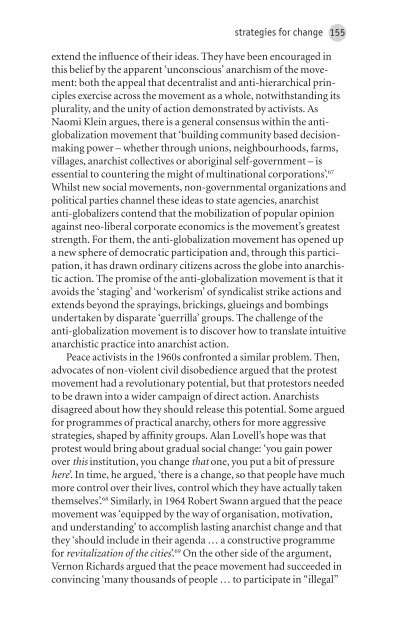o_195qg5dto17o4rbc85q1ge61i84a.pdf
You also want an ePaper? Increase the reach of your titles
YUMPU automatically turns print PDFs into web optimized ePapers that Google loves.
strategies for change 155<br />
extend the influence of their ideas. They have been encouraged in<br />
this belief by the apparent ‘unconscious’ anarchism of the movement:<br />
both the appeal that decentralist and anti-hierarchical principles<br />
exercise across the movement as a whole, notwithstanding its<br />
plurality, and the unity of action demonstrated by activists. As<br />
Naomi Klein argues, there is a general consensus within the antiglobalization<br />
movement that ‘building community based decisionmaking<br />
power – whether through unions, neighbourhoods, farms,<br />
villages, anarchist collectives or aboriginal self-government – is<br />
essential to countering the might of multinational corporations’. 67<br />
Whilst new social movements, non-governmental organizations and<br />
political parties channel these ideas to state agencies, anarchist<br />
anti-globalizers contend that the mobilization of popular opinion<br />
against neo-liberal corporate economics is the movement’s greatest<br />
strength. For them, the anti-globalization movement has opened up<br />
a new sphere of democratic participation and, through this participation,<br />
it has drawn ordinary citizens across the globe into anarchistic<br />
action. The promise of the anti-globalization movement is that it<br />
avoids the ‘staging’ and ‘workerism’ of syndicalist strike actions and<br />
extends beyond the sprayings, brickings, glueings and bombings<br />
undertaken by disparate ‘guerrilla’ groups. The challenge of the<br />
anti-globalization movement is to discover how to translate intuitive<br />
anarchistic practice into anarchist action.<br />
Peace activists in the 1960s confronted a similar problem. Then,<br />
advocates of non-violent civil disobedience argued that the protest<br />
movement had a revolutionary potential, but that protestors needed<br />
to be drawn into a wider campaign of direct action. Anarchists<br />
disagreed about how they should release this potential. Some argued<br />
for programmes of practical anarchy, others for more aggressive<br />
strategies, shaped by affinity groups. Alan Lovell’s hope was that<br />
protest would bring about gradual social change: ‘you gain power<br />
over this institution, you change that one, you put a bit of pressure<br />
here’. In time, he argued, ‘there is a change, so that people have much<br />
more control over their lives, control which they have actually taken<br />
themselves’. 68 Similarly, in 1964 Robert Swann argued that the peace<br />
movement was ‘equipped by the way of organisation, motivation,<br />
and understanding’ to accomplish lasting anarchist change and that<br />
they ‘should include in their agenda … a constructive programme<br />
for revitalization of the cities’. 69 On the other side of the argument,<br />
Vernon Richards argued that the peace movement had succeeded in<br />
convincing ‘many thousands of people … to participate in “illegal”




